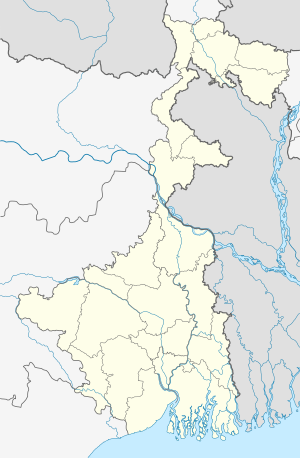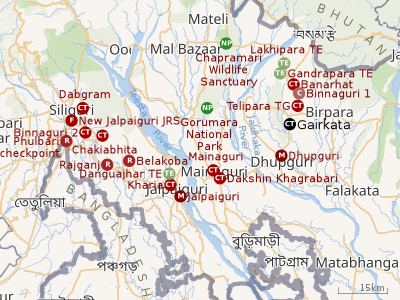Gairkata
Gairkata is a census town in the Dhupguri CD block in the Jalpaiguri Sadar subdivision of the Jalpaiguri district in the state of West Bengal, India. It is the native town of prominent Bengali writer Samaresh Majumdar, poet and journalist Bikash Sarkar and CPI leader Samar Ganguly. Gairkata, home to Gosaihat Eco-Park (located in the Gairkata-Moraghat Range), features Telipara as its main industrial hub. An NGO named Aaranyak was also located in Gairkata.
Gairkata | |
|---|---|
Census Town | |
 Gairkata Location in West Bengal, India  Gairkata Gairkata (India) | |
| Coordinates: 26.68°N 89.03°E | |
| Country | |
| State | West Bengal |
| District | Jalpaiguri |
| Population (2011) | |
| • Total | 7,577 |
| Languages | |
| • Official | Bengali, English |
| Time zone | UTC+5:30 (IST) |
| ISO 3166 code | IN-WB |
| Vehicle registration | WB |
| Lok Sabha constituency | Alipurduars (ST) |
| Vidhan Sabha constituency | Madarihat |
| Website | jalpaiguri |
Geography
 |
| Places and tea estates in Jalpaiguri Sadar subdivision (including Rajganj, Jalpaiguri, Maynaguri and Dhupguri CD blocks) in Jalpaiguri district CT: census town, R: rural/ urban centre, N: neighbourhood, C: cantonment, NP: national park/ wildlife sanctuary, TE: tea estate Abbreviations used in names – TG for Tea Garden (town/village), TE for Tea Estate, JRS: junction railway station Owing to space constraints in the small map, the actual locations in a larger map may vary slightly |
Location
Gairkata is located at 26.68°N 89.03°E.[1]; on the route of Asian Highway 48 and the major junction from Phuentsholing to Changrabandha. Gairkata is located in the middle of the Dhupguri block.
Area overview
The map alongside shows the alluvial floodplains south of the outer foothills of the Himalayas. The area is mostly flat, except for low hills in the northern portions.[2][3]It is a primarily rural area with 62.01% of the population living in rural areas and a moderate 37.99% living in the urban areas.[4][5]Tea gardens in the Dooars and Terai regions produce 226 million kg or over a quarter of India's total tea crop. [6][7] Some tea gardens were identified in the 2011 census as census towns or villages. [8]Such places are marked in the map as CT (census town) or R (rural/ urban centre). Specific tea estate pages are marked TE.
Note: The map alongside presents some of the notable locations in the subdivision. All places marked in the map are linked in the larger full screen map.
Demographics
According to the 2011 Census of India, Gairkata had a total population of 7,577 of which 3,827 (51%) were males and 3,750 (49%) were females. There were 749 persons in the age range of 0 to 6 years. The total number of literate people in Gairkata was 5,506 (80.64% of the population over 6 years).[9]
Gairkata census town has total administration over 1,749 houses, to which it supplies basic amenities such as water and sewerage. It is also authorized to build roads within Census Town limits and impose taxes on properties under its jurisdiction. Caste Factor Gairkata (CT) of Jalpaiguri has a substantial population of Schedule Caste. Schedule Caste (SC) constitutes 31.38% while Schedule Tribe (ST) were 17.08% of total population in Gairkata (CT). [10]
In the 2001 India census, Gairkata had a total population of 8713. At that time, males constituted approximately 51% of the population, whereas females consisted of 49% of the overall population. [11]
Infrastructure
According to the District Census Handbook 2011, Jalpaiguri, Gairkata covered an area of 2.96 km2. Among the civic amenities, it had 17 km roads with open drains, the protected water supply involved overhead tanks, uncovered wells. It had 1,200 domestic electric connections, 60 road lighting points. Among the medical facilities it had 5 dispensaries/ health centres, 1 veterinary hospital. Among the educational facilities it had 6 primary schools, 2 middle schools, 2 secondary schools, 2 senior secondary schools, the nearest general degree college at Dhupguri 14 km away. It had 1 recognised shorthand, typewriting and vocational training institution, 2 non-formal education centres (Sarva Shiksha Abhiyan). Among the social, recreational and cultural facilities it had 1 working women’s hostel. It had branch of 1 nationalised bank.[12]
Education
Banarhat Kartik Oraon Hindi Government College was established at Banarhat in 2014. Affiliated with the University of North Bengal, it is a Hindi-medium institution offering courses in arts and science.[13]
References
- "Yahoo maps location of Gairkata". Yahoo maps. Retrieved 30 December 2008.
- Debnath, S. (2010). The Dooars in Historical Transition (PDF). Shiv Mandir: N. L. Publishers.
- Dinerstein, E., Loucks, C. (2001). "Terai-Duar savanna and grasslands". Terrestrial Ecoregions. World Wildlife Fund.
- "Jalpaiguri". District Profile. District administration. Retrieved 13 July 2020.
- "District Statistical Handbook 2014 Jalpaiguri". Tables 2.2, 2.4b,. Department of Planning and Statistics, Government of West Bengal. Retrieved 13 July 2020.CS1 maint: extra punctuation (link)
- "Tea Growing Regions". Dooars and Terai. Indian Tea Association. Retrieved 13 July 2020.
- "Dooars-Terai". Tea Board India. Retrieved 13 July 2020.
- "2011 Census – Primary Census Abstract Data Tables". West Bengal – District-wise. Registrar General and Census Commissioner, India. Retrieved 13 July 2020.
- "2011 Census – Primary Census Abstract Data Tables". West Bengal – District-wise. Registrar General and Census Commissioner, India. Retrieved 2 July 2020.
- "Gairkata Population Census 2011". census2011.co.in. Retrieved 20 June 2018.
- "Census of India 2001: Data from the 2001 Census, including cities, villages and towns (Provisional)". Census Commission of India. Archived from the original on 16 June 2004. Retrieved 1 November 2008.
- "District Census Handbook Jalpaiguri, Census of India 2011, Series 20, Part XII A" (PDF). Section II Town Directory, Pages 451-453: Statement I: Status and Growth History, Pages 454-455: Statement II: Physical Aspects and Location of Towns, Pages 456-457: Statement III: Civic and other Amenities, Pages 458-459: Statement IV: Medical Facilities 2009, Pages 460—463: Statement V: Educational, Recreational and Cultural Facilities, Pages 464: Statement VI:Industry and Banking. Directorate of Census Operations V, West Bengal. Retrieved 26 June 2020.
- "Banarhat Kartik Oraon Hindi Government College". BKOHGC. Retrieved 29 June 2020.